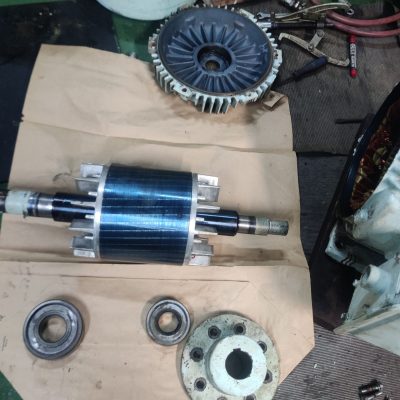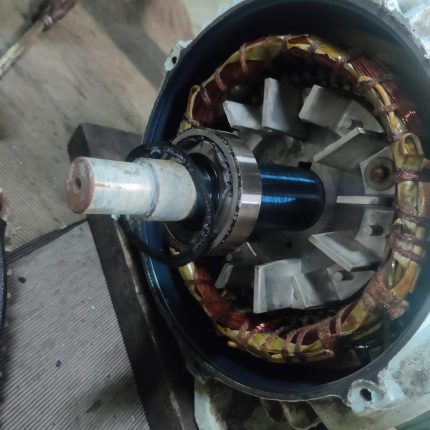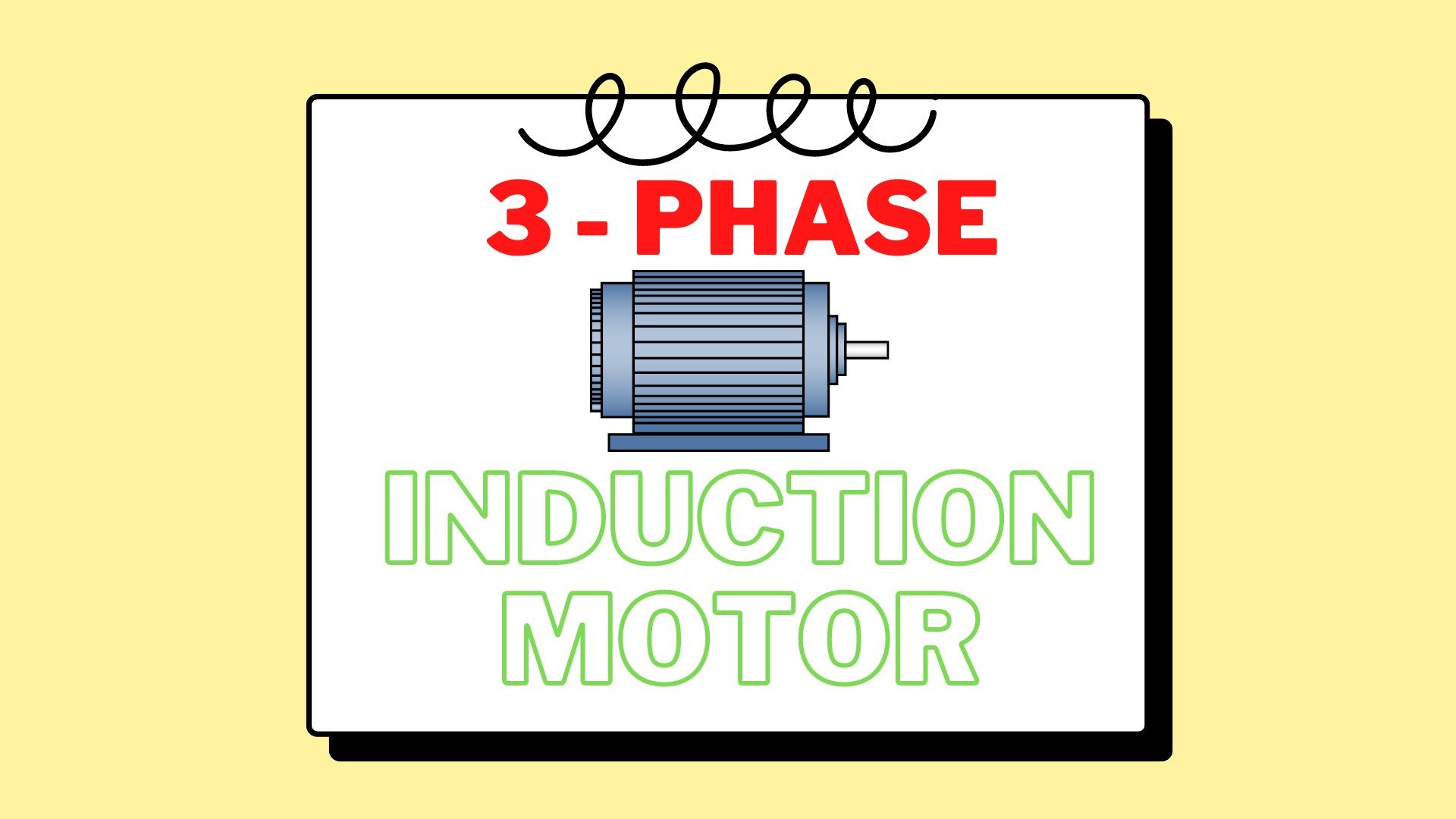3-phase induction motors are a type of electric motor that use three-phase alternating current (AC) to produce a rotating magnetic field. They are widely used in industrial and commercial applications for tasks such as driving pumps, fans, and conveyors.
A 3-phase induction motor consists of a stator and a rotor. The stator is the stationary part of the motor, and it consists of a series of windings or coils that are arranged around a central core. The rotor is the rotating part of the motor, and it consists of a set of conductors that are mounted on a shaft and surrounded by a housing.
Table of Contents
ToggleConstruction of 3-phase induction motor
A three-phase induction motor consists of several key components, including the stator, rotor, bearings, and enclosure. Here is a more detailed description of each of these parts:


Stator: The stator is the stationary part of the motor, and it consists of a series of windings or coils that are arranged around a central core. The stator windings are connected to a three-phase power source, and when an alternating current (AC) is applied to the windings, it creates a rotating magnetic field.
Rotor: The rotor is the rotating part of the motor, and it consists of a set of conductors that are mounted on a shaft and surrounded by a housing. There are two main types of rotors used in three-phase induction motors: squirrel cage and wound. Squirrel cage rotors have a series of conductors that are arranged in a cage-like configuration and are connected to a ring at each end. Wound rotors have a set of windings that are similar to those of the stator, and they are connected to a set of slip rings.
Bearings: The rotor is supported by bearings, which are mechanical components that allow the rotor to rotate smoothly and without excessive friction. There are typically two bearings in a three-phase induction motor: one at each end of the rotor shaft.
Enclosure: The stator and rotor are housed within an enclosure, which protects the motor from external influences such as dust, moisture, and debris. The enclosure also helps to dissipate heat and noise generated by the motor. The type of enclosure used in a three-phase induction motor depends on the specific application and operating conditions.
Working principle of 3 phase induction motor
The principle of a three-phase induction motor is based on the phenomenon of electromagnetic induction, which is the process by which an electrical current is induced in a conductor as a result of a changing magnetic field around the conductor. This process was first discovered by Michael Faraday in the early 19th century, and it forms the basis for many important technologies, including generators, transformers, and electric motors.
The stator windings are connected to a three-phase power source, and when an AC is applied to the windings, it creates a rotating magnetic field. The rotor conductors are exposed to this magnetic field, and as the field rotates, it creates a current in the conductors. This current, in turn, creates its own magnetic field, which interacts with the field of the stator. The interaction between these two fields causes the rotor to rotate, and this rotation is transmitted to a load or other device through the shaft of the motor.
Synchronous speed in 3-phase induction motor
The synchronous speed of a three-phase induction motor is the speed at which the magnetic field of the stator rotates. It is determined by the frequency of the applied current and the number of poles in the motor. The synchronous speed is typically expressed in revolutions per minute (RPM).
The formula for calculating the synchronous speed of a three-phase induction motor is as follows:
Ns = (120 * f) / p
where Ns is the synchronous speed, f is the frequency of the applied current (in Hertz), and p is the number of poles in the motor.
For example, if the frequency of the applied current is 60 Hz and the motor has 4 poles, the synchronous speed would be:
Ns = (120 * 60) / 4 = 1800 RPM
What is slip in 3-phase induction motor
In an induction motor, the slip is the difference between the synchronous speed of the motor and the actual speed of the rotor. The synchronous speed is the speed at which the magnetic field of the stator rotates, and it is determined by the frequency of the applied current and the number of poles in the motor. The actual speed of the rotor is slightly slower than the synchronous speed, and the difference between the two speeds is known as the slip.
The slip is an important factor in the operation of an induction motor, as it allows the motor to operate efficiently and maintain a constant torque. The slip allows the rotor to “catch up” to the field of the stator and maintain a constant torque, even as the load on the motor changes. The slip is typically expressed as a percentage of the synchronous speed, and it can be calculated using the following formula:
S= (Ns – N) / Ns
where S is the slip, Ns is the synchronous speed, and N is the rotor speed.
Torque in 3- phase induction motor
In a three-phase induction motor, the torque is the rotational force produced by the motor, which is transmitted through the shaft of the motor to a load or other device. The torque produced by the motor is proportional to the product of the current in the rotor conductors and the strength of the magnetic field. It can be controlled by adjusting the current in the rotor or the strength of the field, or by changing the load on the motor.
The torque of a three-phase induction motor can be expressed as:
T = K * I * B
where T is the torque, K is a constant that depends on the construction of the motor, I is the current in the rotor conductors, and B is the strength of the magnetic field.
The torque of a three-phase induction motor can also be expressed in terms of the slip, which is the difference between the synchronous speed of the motor and the actual speed of the rotor. The formula for calculating the torque in terms of the slip is:
T = (3 * P * s * E) / (2 * p * Ns)
where T is the torque, P is the power of the motor, s is the slip, E is the voltage of the applied current, p is the number of poles in the motor, and Ns is the synchronous speed.
Advantages of 3-phase induction motor
Three-phase induction motors have several advantages over other types of electric motors, including:
Efficiency: Three-phase induction motors are highly efficient, especially at higher speeds. They have low losses and high power factors, which means they can convert a large portion of the electrical energy they consume into mechanical energy.
Reliability: Three-phase induction motors are reliable and have a long service life. They have few moving parts and require little maintenance, which makes them well-suited for continuous operation.
Power: Three-phase induction motors are available in a wide range of power ratings, from a few hundred watts to several hundred horse power. This makes them suitable for a wide range of applications, from small household appliances to large industrial machinery.
Cost: Three-phase induction motors are generally less expensive to manufacture than other types of electric motors, such as DC motors or synchronous motors. They are also less expensive to operate, due to their high efficiency and low maintenance requirements.
Versatility: Three-phase induction motors can be used in a variety of applications and operating conditions, including both indoor and outdoor environments. They are also available in a range of enclosures and mounting configurations, which allows them to be easily integrated into different types of systems.
Difference between 3-phase and Single phase induction motor
Three-phase induction motors and single-phase induction motors are both types of electric motors that use electromagnetic induction to convert electrical energy into mechanical energy. However, there are several key differences between the two types of motors, including:
Power supply: Three-phase induction motors are designed to operate on a three-phase power supply, while single-phase induction motors are designed to operate on a single-phase power supply.
Torque: Three-phase induction motors typically produce higher torque than single-phase induction motors, especially at low speeds. This makes them well-suited for applications that require high torque at low speeds, such as pumps and compressors.
Efficiency: Three-phase induction motors are generally more efficient than single-phase induction motors, especially at higher speeds. This makes them more energy-efficient and cost-effective to operate.
Starting method: Three-phase induction motors can be started directly from the power supply, while single-phase induction motors require an auxiliary starting mechanism, such as a capacitor or a starter winding.
Cost: Three-phase induction motors are generally less expensive to manufacture than single-phase induction motors, due to their simpler construction. However, the cost of a three-phase induction motor may be higher due to the cost of the three-phase power supply and the required power distribution equipment.
Application of 3-phase induction motors
Three-phase induction motors are widely used in a variety of applications, including:
Industrial machinery: Three-phase induction motors are used to drive a wide range of industrial machinery, including pumps, fans, conveyors, and compressors.
HVAC systems: Three-phase induction motors are used in heating, ventilation, and air conditioning (HVAC) systems to drive fans and pumps.
Power generation: Three-phase induction motors are used in power generation plants to drive generators, which convert mechanical energy into electrical energy.
Household appliances: Three-phase induction motors are used in a variety of household appliances, including washing machines, dryers, and refrigerators.
Transportation: Three-phase induction motors are used in electric and hybrid vehicles to power the drivetrain and other systems.
Material handling: Three-phase induction motors are used to drive cranes, hoists, and other material handling equipment.
Agricultural equipment: Three-phase induction motors are used in tractors, combine harvesters, and other agricultural machinery.
